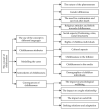Childlessness: Concept Analysis
- PMID: 35162484
- PMCID: PMC8834711
- DOI: 10.3390/ijerph19031464
Childlessness: Concept Analysis
Abstract
The purpose of this concept analysis is to explore childlessness and provide understanding to professionals involved in the field of infertility. Walker and Avant's method was used to identify descriptions, antecedents, consequences, and empirical referents of the concept. A model with related and contrary cases was developed. The analysis was based on the definition of the term in major dictionaries in the Greek, Lithuanian, Finnish, Maltese, and Turkish languages, while further literature searches utilized the Web of Science, PubMed, PsychInfo, Medline, Google Scholar, and National Thesis Databases. The literature search was limited to papers/books published in the authors' national languages and English. As a result, childlessness is defined as the absence of children in the life of an individual, and this can be voluntary or involuntary. However, the deeper analysis of the concept may be preceded and amplified through cultural, psychological, biological, philosophical, theological, sociological, anthropological, and linguistic aspects throughout history. These elements presented challenges for childless individuals, ultimately influencing their choices to resort to alternative ways of becoming parents, such as in vitro fertilization (IVF), surrogacy, adoption, or other forms of childbearing. Historically, childlessness has been viewed with negative connotations due to its potential impact on the survival of the human species. This negativity can be directed even to individuals who may decide to opt to voluntarily remain childfree. The long-term impact of the experience, both on an individual and collective level, continues to cause pain to those who are involuntarily childless. In conclusion, health professionals and other stakeholders who have a deep understanding of childlessness, including the antecedents and attributes, can minimize the potential negative consequences of those factors contributing to childlessness, whether voluntary or involuntary. In fact, they can capitalize on a powerful impact of change adaptation by providing support to those in their practice to recover the lost homeostasis.
Keywords: antinatalism; barrenness; child-free; childlessness; infertile; sterile.
Conflict of interest statement
The authors declare that they have no conflict of interest.
Figures




Similar articles
-
'Either stay grieving, or deal with it': the psychological impact of involuntary childlessness for women living in midlife.Hum Reprod. 2020 Apr 28;35(4):876-885. doi: 10.1093/humrep/deaa033. Hum Reprod. 2020. PMID: 32268357
-
Childlessness in Nigeria: perceptions and acceptability.Cult Health Sex. 2014;16(1):61-75. doi: 10.1080/13691058.2013.839828. Epub 2013 Nov 18. Cult Health Sex. 2014. PMID: 24236953
-
Why no children? Report on a meeting of a Regional Working Group on Psychosocial Aspects of Voluntary and Involuntary Childlessness, held in London (UK) on 10-12 December 1979.IPPF Eur Reg Inf. 1982 Sep:1-24. IPPF Eur Reg Inf. 1982. PMID: 12178361
-
Infertility and assisted reproduction in Denmark. Epidemiology and psychosocial consequences.Dan Med Bull. 2006 Nov;53(4):390-417. Dan Med Bull. 2006. PMID: 17150146 Review.
-
Men's knowledge, attitudes and behaviours relating to fertility.Hum Reprod Update. 2017 Jul 1;23(4):458-480. doi: 10.1093/humupd/dmx005. Hum Reprod Update. 2017. PMID: 28333354 Review.
Cited by
-
Introducing the Hungarian Version of the SCREENIVF Tool into the Clinical Routine Screening of Emotional Maladjustment.Int J Environ Res Public Health. 2022 Aug 16;19(16):10147. doi: 10.3390/ijerph191610147. Int J Environ Res Public Health. 2022. PMID: 36011781 Free PMC article. Clinical Trial.
-
Childlessness and its associated factors among Chinese women: a nationwide population-based study.BMC Public Health. 2025 Feb 17;25(1):638. doi: 10.1186/s12889-025-21829-x. BMC Public Health. 2025. PMID: 39962454 Free PMC article.
-
The role of social determinants of health in woman's intention to pregnancy: a model with the mediation of social support.BMC Public Health. 2025 Mar 19;25(1):1062. doi: 10.1186/s12889-025-22223-3. BMC Public Health. 2025. PMID: 40108586 Free PMC article.
-
The Causes and Role of Antinatalism in Poland in the Context of Climate Change, Obstetric Care, and Mental Health.Int J Environ Res Public Health. 2022 Oct 20;19(20):13575. doi: 10.3390/ijerph192013575. Int J Environ Res Public Health. 2022. PMID: 36294154 Free PMC article.
-
The Relationship Between Serum Anti-Müllerian Hormone and Basal Antral Follicle Count in Infertile Women Under 35 Years: An Assessment of Ovarian Reserve.Cureus. 2023 Dec 8;15(12):e50181. doi: 10.7759/cureus.50181. eCollection 2023 Dec. Cureus. 2023. PMID: 38077683 Free PMC article.
References
-
- Miettinen A., Rotkirch A., Szalma I., Donno A., Tanturri M.L. Increasing childlessness in Europe: Time trends and country differences. Families and Societies. Work. Pap. Ser. 2015;33:1–46.
-
- World Health Organization . International Classification of Diseases, 11th Revision (ICD-11) WHO; Geneva, Switzerland: 2018. [(accessed on 2 June 2021)]. Available online: https://www.who.int/news-room/fact-sheets/detail/infertility.
-
- Biaggi C. The significance of the nudity, obesity and sexuality of the Maltese goddess figures. In: Bonanno A., editor. Archaeology and Fertility Cult in the Ancient Mediterranean, Proceedings of the First International Conference on Archaeology of the Ancient Mediterranean, Msida, Malta, 2–5 September 1985. University of Malta Press; Msida, Malta: 1986. pp. 131–140.
-
- Istomina N., Razbadauskas A. Socialiniai ir multikultūriniai nevaisingumo aspektai Lietuvoje (The social and multicultural problems of infertility in Lithuania) Tiltai. 2003;4:65–73.
Publication types
MeSH terms
LinkOut - more resources
Full Text Sources
Medical
Research Materials

